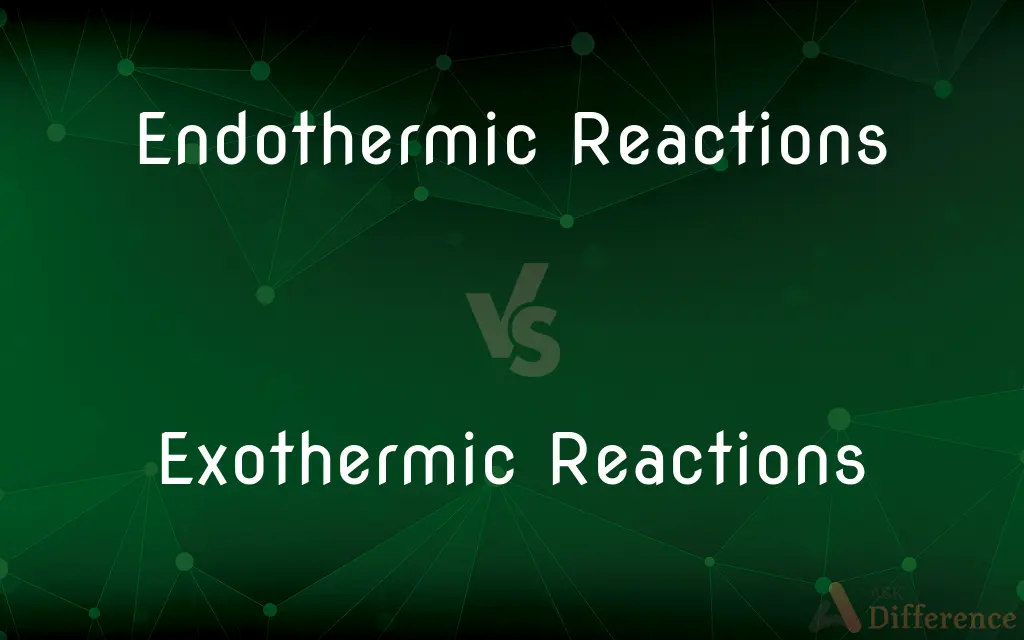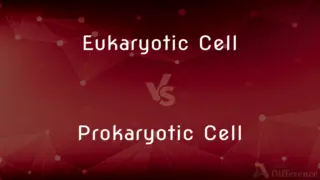Endothermic Reactions vs. Exothermic Reactions — What's the Difference?
By Tayyaba Rehman — Published on October 7, 2023
Endothermic reactions absorb heat from their surroundings, while exothermic reactions release heat into their surroundings.

Difference Between Endothermic Reactions and Exothermic Reactions
Table of Contents
ADVERTISEMENT
Key Differences
Endothermic reactions are characterized by the absorption of heat energy from their surroundings, resulting in a product that stores more energy than the reactants. On the other hand, exothermic reactions release heat energy to the surroundings, resulting in products that have less stored energy than the reactants.
Endothermic reactions typically result in a cooling effect in the local environment where the reaction takes place. Contrarily, exothermic reactions usually cause a heating effect, warming up the local environment due to the release of heat.
Chemically, endothermic reactions can be depicted by positive enthalpy changes, indicating that energy has been absorbed. Exothermic reactions exhibit negative enthalpy changes, showcasing an energy release during the process.
Endothermic reactions may require continuous energy input to proceed, sometimes necessitating an external heat source. In contrast, exothermic reactions often occur spontaneously once initiated, due to the release of energy which can sometimes further propagate the reaction.
In practical applications, endothermic reactions are exploited in processes like photosynthesis, where light energy is absorbed to convert carbon dioxide and water into glucose. Whereas, exothermic reactions find applications in areas like combustion, where substances burn, releasing heat and light energy.
ADVERTISEMENT
Comparison Chart
Energy Flow
Absorbs energy from surroundings
Releases energy to surroundings
Enthalpy Change (∆H)
Positive
Negative
Effect on Surroundings
Cools
Heats
Energy Requirement
Often needs continuous energy input
Often occurs spontaneously
Practical Applications
Photosynthesis
Combustion
Compare with Definitions
Endothermic Reactions
Endothermic reactions typically have a positive change in enthalpy.
The formation of nitrate ions from nitrogen and oxygen is an endothermic reaction due to the positive enthalpy change.
Exothermic Reactions
Exothermic reactions release energy, typically in the form of heat.
Combustion of wood in a fire is an exothermic reaction, releasing heat and light.
Endothermic Reactions
Endothermic reactions may require external energy sources to proceed.
Electrolysis of water is endothermic and requires electricity to proceed.
Exothermic Reactions
The enthalpy change (∆H) in exothermic reactions is negative.
The reaction of hydrogen and oxygen to form water is exothermic, with a negative enthalpy change.
Endothermic Reactions
Endothermic processes are central to biochemical photosynthesis.
In plants, photosynthesis is an endothermic reaction, absorbing sunlight to form glucose from CO2 and water.
Exothermic Reactions
Exothermic reactions are utilized in thermal energy production.
In power plants, the combustion of coal, an exothermic reaction, is used to produce electricity.
Endothermic Reactions
Endothermic reactions absorb heat from the environment.
Melting ice is an endothermic reaction as it absorbs heat to change from solid to liquid.
Exothermic Reactions
Exothermic processes often occur spontaneously once initiated.
The oxidation of iron in a rusty nail is a spontaneous exothermic reaction.
Endothermic Reactions
Endothermic processes often lead to a temperature decrease.
The endothermic reaction in a cold pack cools down the surroundings upon activation.
Exothermic Reactions
Exothermic reactions can result in a temperature increase in the surroundings.
The exothermic reaction in a hand warmer generates heat, warming up your hand in cold weather.
Common Curiosities
Can exothermic reactions be artificially initiated?
Yes, exothermic reactions can be initiated by adding a catalyst or providing initial energy.
What characterizes endothermic reactions?
Endothermic reactions absorb heat from their surroundings.
How do endothermic reactions affect the surrounding temperature?
Endothermic reactions typically decrease the surrounding temperature.
Are endothermic reactions always slow?
No, endothermic reactions can be fast or slow, depending on various factors.
What propels exothermic reactions to continue?
Exothermic reactions often continue due to the release of energy which can further propagate the reaction.
What are the products of exothermic reactions like?
The products of exothermic reactions generally have less stored energy than the reactants.
Do endothermic reactions require energy input?
Often, endothermic reactions require continuous energy input to proceed.
What is a daily life example of an exothermic reaction?
A burning candle exemplifies a common exothermic reaction.
What is an example of an exothermic reaction?
Combustion of gasoline is a classic example of an exothermic reaction.
How is enthalpy change represented in exothermic reactions?
In exothermic reactions, enthalpy change (∆H) is typically negative.
Are all chemical reactions either endothermic or exothermic?
Yes, all chemical reactions are either endothermic (absorb energy) or exothermic (release energy).
Why are endothermic reactions important in biology?
Endothermic reactions, like photosynthesis, are vital for energy storage in biological systems.
What safety precautions are necessary for exothermic reactions?
Precautions include managing heat release and avoiding burns, as exothermic reactions can be hot and potentially dangerous.
How do endothermic reactions feel to the touch?
Endothermic reactions typically feel cold to the touch due to energy absorption.
Can endothermic reactions occur spontaneously?
Rarely, as endothermic reactions usually require an energy source to proceed.
Share Your Discovery

Previous Comparison
Eukaryotic Cell vs. Prokaryotic Cell
Next Comparison
Oral Communication vs. Verbal CommunicationAuthor Spotlight
Written by
Tayyaba RehmanTayyaba Rehman is a distinguished writer, currently serving as a primary contributor to askdifference.com. As a researcher in semantics and etymology, Tayyaba's passion for the complexity of languages and their distinctions has found a perfect home on the platform. Tayyaba delves into the intricacies of language, distinguishing between commonly confused words and phrases, thereby providing clarity for readers worldwide.
















































